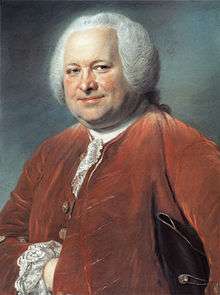Hélène-Louise Demars
Hélène-Louise Demars (born c. 1736) was French composer. She wrote several works including cantatas dedicated to nobles such as Mademoiselle de Soubise of the Rohan family and Madame La Marquise de Villeroy. She went on to become a teacher of several instruments such as the harpsichord and the violin.[1][2]
Early life
Helene-Louise Demars was born in 1736. Though the location of her birth is not documented, she was most likely born in Paris, since her father, Jean-Odéo Demars[3] was a musician at two churches in Paris. This can also be inferred because all her documented works were printed in Paris. Information about her mother and existence of other siblings are unknown, Demars lived with her mother and siblings in the Rue St. Thomas du Louvre], when her father died in 1756.[4]
With influences from her musical father, she mostly likely learned from him as he played and composed songs for the Church.

Personal life
Demars married Jean-Baptiste Vernier, a violinist and music dealer specializing in foreign editions in 1759.[5] It is unknown if she and her husband had any children. Throughout her life, she may have worked with her husband to support the music shop.
Career and Works
According to its number of references among sources, her most cited-work, "L'Horoscope"[6] is Demars' most well-known work, which is dedicated to Mademoiselle de Soubise of the Rohan family. It was performed for the dedicatee as early as November 21, 1748, when Demars was about 12 years old. It was then published in the Mercure de France the following year in 1749 She also dedicated her work called "Hercule et Omphale"[7] to Madame La Marquise de Villeroy. She has several other works that she has composed:[8]
Demars also became a member of Alexandre Jean-Joseph Le Riche de la Pouplinière's circle,[9] who "is famed as one of the most influential patrons of the Enlightenment Era. He and his circle of rising musicians, and artists may have been her most "influential contact" at this time, for he was to other musicians such as Jean-Philippe Rameau. Through this group she was probably introduced to other artists of her time as well as acquired patrons whom she could compose and play songs for. It is possible that, at one point, she lived in la Pouplinière's home in Paris, since he welcomed artists and luminaries to stay there.

Not only a composer, she was also a teacher. She taught the violin and the harpsichord. She was advertised in the "Tableau de Paris pour l'annee 1759," as a "maîtresses" or "teacher" of the harpsichord.
Bibliography
- Brain, Corisha. A social, literary and musical study of Julie Pinel's Nouveau recueil d'airs serieux et à boire. A social, literary and musical study of Julie Pinel's Nouveau recueil d'airs serieux et à boire 1. N.p.: New Zealand School of Music, 2008.
- Curtis, Alan S. Jean-Philippe Rameau. http://www.britannica.com/. Accessed May 4, 2016.
http://www.britannica.com/biography/Jean-Philippe-Rameau.
- Demars, Hélène-Louise. Hercule et Omphale, 1re cantatille à voix seule et simphonie.
- Demars, Hélène-Louise. L'horoscope Cantate, du Meme" [The Horoscope Song, of the same]. Mercure de France, March 1749, 40-41.
- David Fuller and Bruce Gustafson. Demars, Jean Odéo. Grove Music Online. Oxford Music Online. Oxford University Press, accessed April 1, 2016, http://www.oxfordmusiconline.com/subscriber/article/grove/music/07526 .
- Hoffmann, Freia. Mars, Hélène-Louise de, verh. Vernier, Venier, Vernieri.
http://www.sophie-drinker-institut.de/. Last modified 2007. Accessed May 4, 2016. http://www.sophie-drinker-institut.de/cms/index.php/mars-helene- louise.
- Jackson, Barbara Garvey. Say Can You Deny Me: A Guide to Surviving Music by Women from the 16th
through the 18th Centuries. N.p.: University of Arkansas Press, 1994.
- M. Brenet: 'La librairie musical en France de 1653 à 1790 d'après les registres de privilèges'. SIMG, viii (1906-7), 447
- van Boer, Bertil. Historical Dictionary of Music of the Classical Period (Historical Dictionaries of Literature and the Arts). N.p.: Scrarecrow Press, 2-12.
- Demars, Hélène-Louise. In The Norton/Grove Dictionary of Women Composers, edited by Julie Anne Sadie and Rhian Samuel, 139-40. N.p.: W. W. Norton & Company, 1995.
- Hoffmann, Freia. Mars, Hélène-Louise de, verh. Vernier, Venier, Vernieri.
http://www.sophie-drinker-institut.de/. Last modified 2007. Accessed May 4, 2016. http://www.sophie-drinker-institut.de/cms/index.php/mars-helene- louise.
- Curtis, Alan S. Jean-Philippe Rameau. http://www.britannica.com/. Accessed May 4, 2016.
http://www.britannica.com/biography/Jean-Philippe-Rameau.
References
- ↑ Brain, Corisha. "A literary and musical study of Julie Pinel's Nouveau receuil d'airs sérioux et à boire" (PDF). Retrieved 30 November 2010.
- ↑ Sadie, Julie Anne; Samuel, Rhian (1994). The Norton/Grove dictionary of women composers (Digitized online by GoogleBooks). Retrieved 4 October 2010.
- ↑ David Fuller and Bruce Gustafson. "Demars, Jean Odéo". Retrieved 4 May 2016.
- ↑ Hoffmann, Freia. "Mars, Hélène-Louise de, verh. Vernier, Venier, Vernieri". Retrieved 4 May 2016.
- ↑ Sadie, Julie Anne; Samuel, Rhian (1994). The Norton/Grove dictionary of women composers (Digitized online by GoogleBooks). Retrieved 4 October 2010.
- ↑ Demars, Helene-Louise. "L'horoscope Cantate, du Meme". Retrieved 4 May 2016.
- ↑ Demars, Helene-Louise. "Hercule et Omphale". Retrieved 4 May 2016.
- ↑ Brain, Corisha. "A literary and musical study of Julie Pinel's Nouveau receuil d'airs sérioux et à boire" (PDF). Retrieved 30 November 2010.
- ↑ Curtis, Alan S. "Jean-Philippe Rameau". Retrieved 4 May 2016.